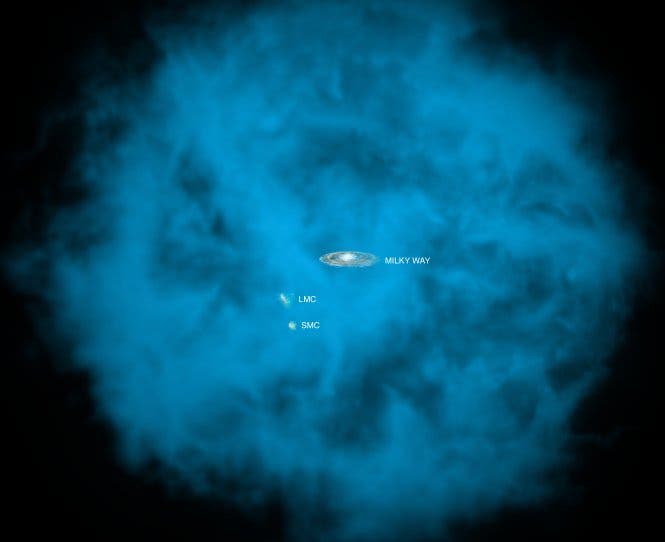Recent measurements conducted by NASA’s Chandra X-ray Observatory, and observed by other X-ray instruments from around world and in space, suggest that our galaxy is surrounded by hot spherical gas formation that stretches across 300,000 light years and has an equivalent mass of some 60 billion suns or roughly all the stars in the Milky Way. If these findings are indeed confirmed then they might provide a valid explanation for the “missing baryon” problem.

This highly important find occurred while scientists were studying bright x-ray sources located millions of light years away and observed that oxygen ions in the immediate vicinity of our galaxy were oddly “selectively absorbing” some of the x-rays. This oddity was also picked up by the European Space Agency’s XMM-Newton space observatory and Japan’s Suzaku satellite.
Using these measurements, the astronomers were able to set limits on the temperature, extent and mass of the hot gas halo. Thus, they determined the temperature of the absorbing halo is between 1 million and 2.5 million kelvins, or a few hundred times hotter than the surface of the sun, which gives weight to previous studies which had galaxies covered in warm gas with temperatures between 100,000 and 1 million kelvins.
“We know the gas is around the galaxy, and we know how hot it is,” said Anjali Gupta, lead author of The Astrophysical Journal paper describing the research. “The big question is, how large is the halo, and how massive is it?”
Our galaxy is surrounded in thin cloud of gas stretching across hundreds of thousands of years
They concluded that the mass of the gas is equivalent to the mass in more than 10 billion suns, perhaps as large as 60 billion suns, an estimation that primarily factored in the amount of oxygen relative to hydrogen, which is the dominant element in the gas. Still, considering the gas halo is extremely vast, this makes it very low density, making observations of similar gas halos embedding other galaxies almost impossible using today’s instruments. Yet, if confirmed, scientists might assert that this halo is present around many, if not most galaxies in the Universe.
“Our work shows that, for reasonable values of parameters and with reasonable assumptions, the Chandra observations imply a huge reservoir of hot gas around the Milky Way,” said co-author Smita Mathur of Ohio State University in Columbus. “It may extend for a few hundred thousand light-years around the Milky Way or it may extend farther into the surrounding local group of galaxies. Either way, its mass appears to be very large.”
It also might untangle a riddle which has been pestering scientists for decades, namely the missing baryon problem. Baryons are particles, such as protons and neutrons, that make up more than 99.9 percent of the mass of atoms found in the cosmos. A while ago, scientists tried estimated the number of atoms and ions that would have been present in the Universe 10 billion years ago. Measurements however showed that only half of the estimated baryons were located. Other studies suggests hints that the missing baryons are stranded in a sort of cosmic web, consisting of a vast gas cloud formations connecting galaxies between each other.
Chandra’s latest findings seems to add substance to this particular theory. These were reported in Sept. 1 issue of The Astrophysical Journal.
source: NASA






